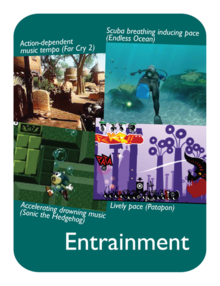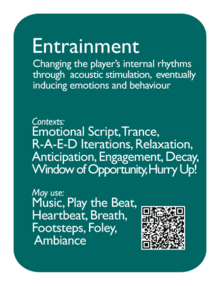Entrainment
From SoundInGames.com - Sound Design in Games
Revision as of 12:56, 18 August 2011 by ValterAlves (Talk | contribs)

|

| |
| The card's front face | The card's back face |
Synopsis
| Changing the player’s internal rhythms through acoustic stimulation, eventually inducing emotions and behaviour. |
Relationships
Contexts:
Emotional Script ![]() , Trance
, Trance ![]() , R-A-E-D Iterations
, R-A-E-D Iterations ![]() , Relaxation
, Relaxation ![]() , Anticipation
, Anticipation ![]() , Engagement
, Engagement ![]() , Decay
, Decay ![]() , Window of Opportunity
, Window of Opportunity ![]() , Hurry Up!
, Hurry Up! ![]() .
.
May use:
Music ![]() , Play the Beat File:M385px-PlayTheBeat-front-v20.png, Heartbeat
, Play the Beat File:M385px-PlayTheBeat-front-v20.png, Heartbeat ![]() , Breath
, Breath ![]() , Footsteps
, Footsteps ![]() , Foley
, Foley ![]() , Ambiance
, Ambiance ![]() .
.
Description
Entrainment can be used to support the maintenance or the change of emotional states, by influencing the player to progressively move from one state of resonance into another. Sound is one prominent way to implement entrainment, benefiting from the way humans resonate to auditory stimuli. The principles of entrainment and resonance have been exploited by music through the ages[1][2][3].
Examples
External Resources
- First presentation of the pattern Entrainment[4]
- On the concept and physics of entrainment[1][2][3]
- Entrainment in Sound Design in Games[5][6]
- ↑ Cite error: Invalid
<ref>tag; no text was provided for refs namedAugoyard - ↑ Cite error: Invalid
<ref>tag; no text was provided for refs namedLeeds - ↑ Cite error: Invalid
<ref>tag; no text was provided for refs namedSonnenschein - ↑ Cite error: Invalid
<ref>tag; no text was provided for refs namedAlvesAM10 - ↑ Cite error: Invalid
<ref>tag; no text was provided for refs namedAlvesAM09 - ↑ Cite error: Invalid
<ref>tag; no text was provided for refs namedAlvesCh11





